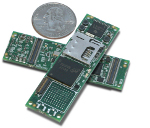Reducing the power and physical size of chipsets required for new and existing Internet-of-Things devices is a common goal shared by our customers and engineers – and a new SoC from Redpine Signals fits the bill.
Their RS9113 “M2MCombo” chipset is a system-on-chip which offers the convergence of low-power dual-band 802.11n Wi-Fi networking together with dual-mode Bluetooth 4.0 and ZigBee connectivity all in a single chip – offering a powerful and nearly universal wireless communications platform for IoT and machine-to-machine applications.
This is particularly valuable for M2M and Internet-of-Things applications where a compact and cost-effective solution with minimum bill-of-materials cost is desired while also implementing a combination of Bluetooth, ZigBee and Wi-Fi communications – for example in network gateways in home automation or smart energy applications that are aggregating data from a number of Bluetooth, Wi-Fi and ZigBee devices around the home.
The Redpine “M2MCombo” platform leverages and improves upon the proven low-power innovations in Redpine’s Lite-Fi products, providing a powerful three-in-one Wi-Fi, Bluetooth 4.0 and ZigBee convergence solution for integration into mobile and wireless devices.
With the rapid proliferation of different networking protocols in the fast-growing Internet-of-Things and M2M industry, manufacturers of wireless devices need cost-effective wireless connectivity solutions to remain competitive in the market, and bringing together several different wireless communication protocols in a single-chip solution helps to make that possible.
Furthermore the M2MCombo solution from Redpine not only provides a compact and cost-effective solution where these multiple communications protocols are required, but also speeds up the product development lifecycle by taking care of the engineering challenges around the coexistence of multiple different RF platforms in the same 2.4 GHz band.
The difficulty of making three separate radios play nicely close to each other is removed, while reducing size, power consumption and cost at the same time, enabling you to get on with product development without much specialist RF engineering.
The RS9113 M2MCombo chipset integrates a four-threaded processor along with RAM and ROM in a fully self-contained solution, with the capacity to run its TCP/IP stack and the Wi-Fi security supplicant locally on the radio chipset.
This means that the host microcontroller and its resources are not carrying the load of hosting the network stack or any other components, allowing a cheaper and lower-power host microcontroller to be chosen in power-sensitive and cost-sensitive IoT applications.
As a convergence device, the RS9113 supports 802.11n Wi-Fi, Bluetooth 2.1 Enhanced Data Rate, Bluetooth 3.0, Bluetooth 4.0 and ZigBee, and maintains wireless connections on some or all of these interfaces simultaneously – making it ideal for multiple-protocol gateway or network bridge applications.
The SoC provides virtually simultaneous multiple-protocol connectivity across these different radios; a valuable feature for a broadly compatible IoT networking platform, which can be deployed quickly in legacy network environments as well as new network environments.
For example – a network gateway appliance implemented with the RS9113 could communicate with a fitness or medical sensor device that uses single-mode Bluetooth 4.0 connectivity, a smartphone with Bluetooth and WiFi connectivity, and a home automation device with ZigBee connectivity – all at the same time, and without the need for multiple different radio modules from different vendors in the gateway unit, all trying to coexist on the same RF spectrum, adding cost, adding size, power consumption and RF coexistence challenges.
And with its highly efficient Power Management Unit, integrated analogue peripherals and support for a variety of digital peripherals – the RS9113 enables very cost-effective solutions for embedded wireless, M2M and Internet-of-Things applications using a combination of Wi-Fi, ZigBee or Bluetooth.
An IoT-enabled product can be designed around the chipset, with relatively few external components needed – generally few or no analog peripherals, power management peripherals, or other RF and wireless connectivity chipsets or modules are required, depending on your exact application.
Development of RS9113 based IoT solutions is made easier by the accompanying OneBox embedded software framework from Redpine. OneBox supports WiFi station or AP, Wi-Fi Direct, ZigBee and dual-mode Bluetooth 4.0 communications – all based around a common API, on a range of host platforms and different embedded operating system options.
The software package includes complete reference firmware builds, reference drivers, application profiles and a configuration GUI that can be used on Linux, Windows or Android operating systems.
Working with external devices to the RS9113 chipset is easy thanks to support for a number of different hardware host interfaces – including USB 2.0, SDIO, SPI and UART. This offers a great deal of flexibility and compatibility to designers and system integrators.
Redpine offers SDIO, SPI, UART, and USB2.0 reference designs along with software for factory-level testing and diagnostics for your product. Along with a development environment and a complete reference framework for creating connected applications using the RS9113, Redpine also offers an easy-to-use USB-interfaced hardware development kit for the chipset.
Here at the LX Group we’re really excited about the possibilities of working with Redpine’s RS9113 “M2MCombo” chipset and the resulting products that are possible. Not only do we share your passion for embedded hardware and the Internet-of-Things, our team of solutions architects, engineers and specialists is ready to partner with you for your success in the IoT marketplace. Getting started is easy – click here to contact us, or telephone 1800 810 124.
LX is an award-winning electronics design company based in Sydney, Australia. LX services include full turnkey design, electronics, hardware, software and firmware design. LX specialises in embedded systems and wireless technologies design.
Published by LX Pty Ltd for itself and the LX Group of companies, including LX Design House, LX Solutions and LX Consulting, LX Innovations.





